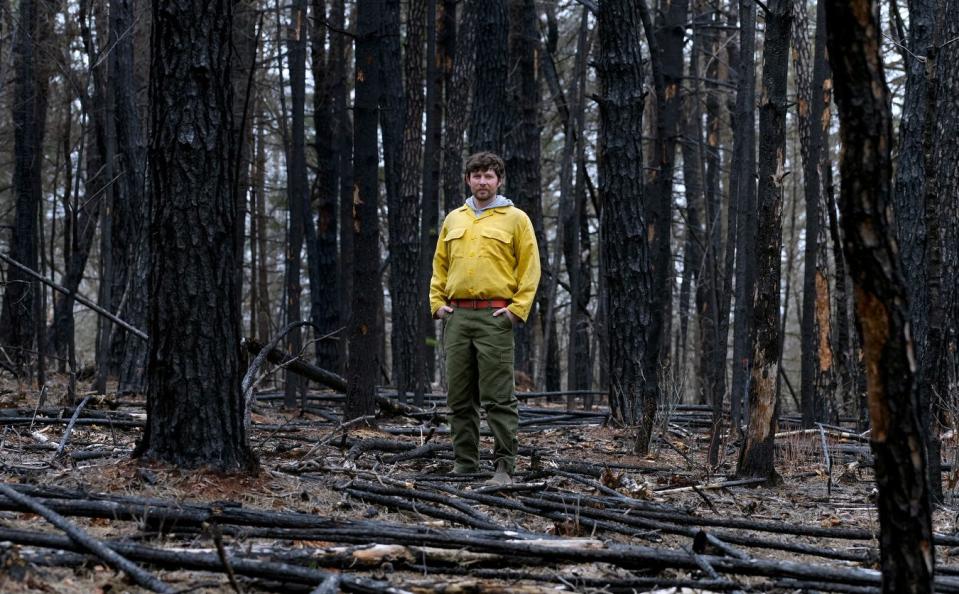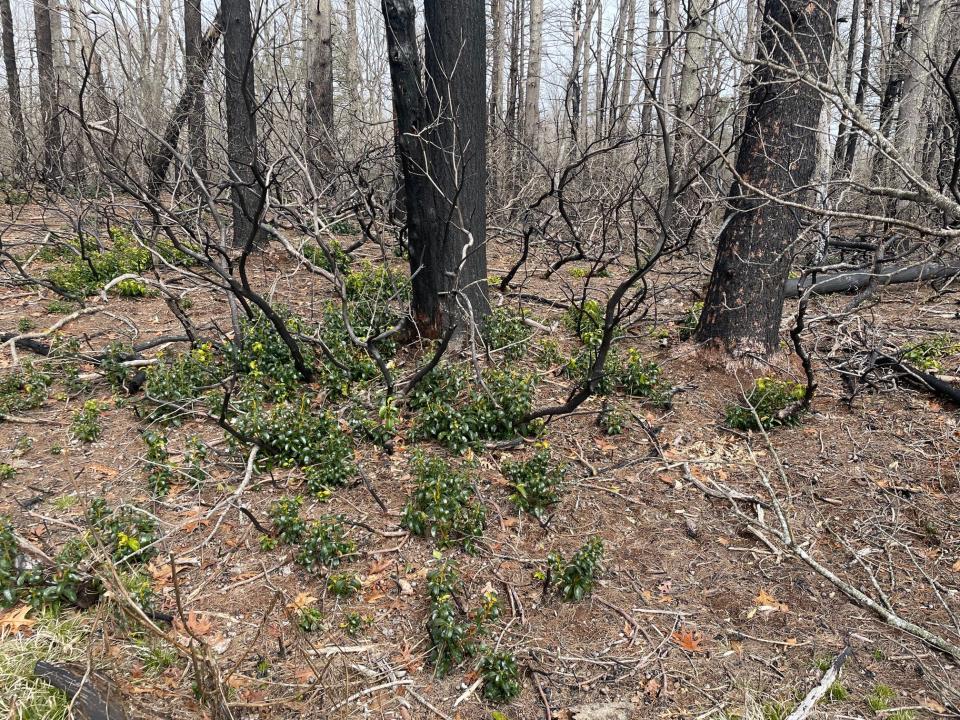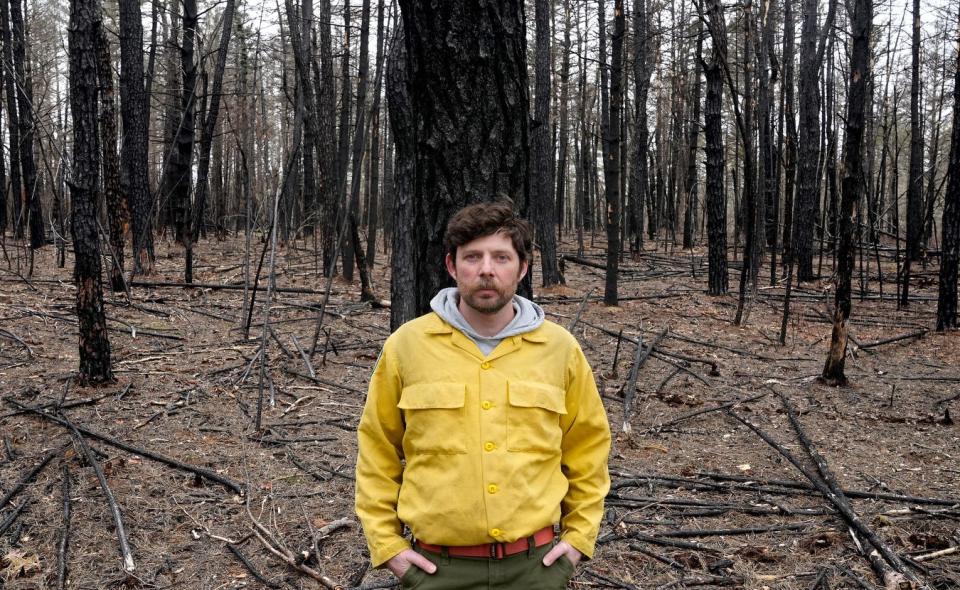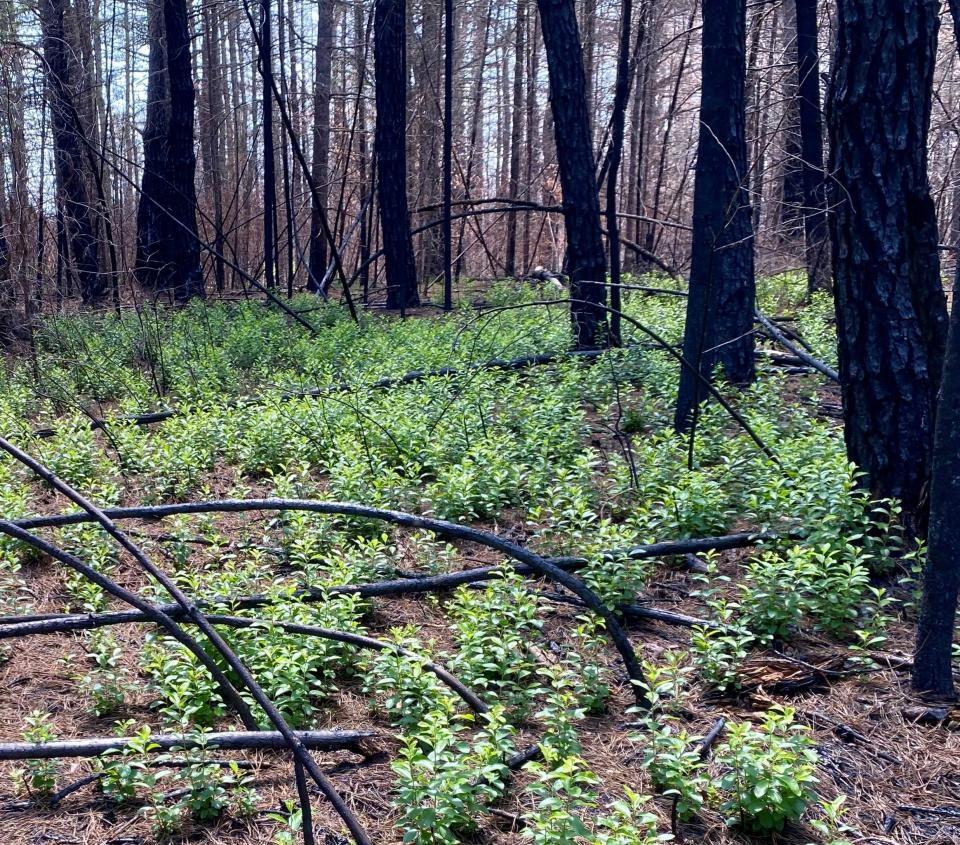Spring is fire season. Will RI have another bad wildfire this year?
EXETER – Within the charred remains of a mountain laurel thicket, green shoots are sprouting from the ground.
The new growth is evidence that the woodlands in the Queen’s River Preserve that were decimated by wildfire a year ago are slowly recovering. It’s not just the laurels that are springing back to life. White pine saplings are returning. And come summer, the forest floor should be covered again in blueberry bushes.
There are still dead and charred trees across a quarter of the 188-acre preserve, but The Nature Conservancy, which owns the property, is leaving them standing as places to hunt and nest for woodpeckers and other birds.
“This pitch pine forest is a plant community that evolved with fire,” said Tim Mooney, spokesman for the organization. “The plan right now is to let that play out.”

Fire last year was among largest in recent state history
The blaze that began in the preserve one Friday last April was among the largest wildfires in Rhode Island in the last 70 years.
By the time firefighters from Exeter, surrounding communities and the state Department of Environmental Management team that specializes in wildfires had put out the last flames, the blaze had burned through 238 acres of forest.
That fire, and another smaller one a few days earlier in the Big River Management Area in West Greenwich, helped spur the creation of a special legislative commission that is looking at long-term solutions to manage the state’s forests, in part to prevent similar conflagrations from occurring.
In the meantime, Pat MacMeekin, forest fire program manager with the DEM, is keeping his eye on the weather this spring and hoping that he doesn’t see conditions like last year’s again.

“Last year was just a perfect storm,” he said. “It was a really hot and dry day, and the winds were howling. The fire got big really quick.”
So far this year, there’s been only one large brushfire in the state. It happened March 20 in Charlestown and burned across 13 acres.
An Amtrak train passing through the area reported smoke in the woods early in the morning, said MacMeekin. The fire was in a remote spot with no access by road, so firefighters had to hike in.
“It was an all-day effort,” he said.
Wildfires are more common in the Northeast in the spring
Spring is wildfire season in the Northeast. After the snow melts and temperatures rise, the sun breaks through the forest, unimpeded by bare trees. It dries out leaf litter, pine needles and other debris dropped by trees over the winter, creating a layer of kindling on the forest floor.
Once the trees leaf out, they block the sun and prevent evaporation, keeping the ground moist and the air more humid, tamping down the risk of fire. But from late February until mid-May, when humidity levels tend to be low and winds can pick up quickly, fire is a constant worry.
Rain is an obvious deterrent. And the past few months have been unusually wet, with total precipitation in the Providence metro area since New Year's Day 85% higher than normal as of March 27, according to Lenny Giuliano, state meteorologist with the DEM.

But even when the ground is wet, it can dry out quickly.
“And although it’s true that a wetter winter is better for drought conditions, it also creates more vegetation in the form of native and nonnative grasses,” said DEM spokesman Michael Healey. “Moist fuels are an ideal fire retardant, but these grasses are susceptible to drying out after just a short spell of low humidity and higher temperatures. Once dried, they ignite easily.”
The upshot is that spring fires tend to stay above ground, making them generally easier to fight.
“Later in the summer, if drought conditions persist, that soil moisture starts to dry up,” MacMeekin said. “This means a wildfire can start to burn down into the ground through tree roots and buried organic matter.”
What's being done to prevent future wildfires?
As to lessons learned from last year’s fires, one of the priorities of the legislative commission created by Rep. Megan Cotter, D-Exeter, is ensuring that fire crews can get into areas where wildfires are burning.
The DEM plans to lead an effort to map all the existing fire roads in the state. And conservation groups are considering alternatives to roadblocks designed to keep ATVs and other prohibited vehicles off their properties.
The Nature Conservancy, which protects thousands of acres in Rhode Island, has already started removing boulders at preserve entrances and is looking to replace them with gates that would use a common key or combination lock, said Mooney.
“The fire last year highlighted the importance of access,” he said.

It’s also focused attention on staffing at the DEM’s forest environment division, where the five-person forest fire program headed by MacMeekin is housed. Although staffing levels have increased at the state agency in recent years, they’re still below where they were in the early 2000s.
The DEM has worked to expand its firefighting capabilities by training staff outside of the forest fire program to respond to wildfires. With another two employees set to be hired in the forest division, there would be more than 20 people with wildfire training at the agency.
That number would grow after the forest fire program holds its annual weeklong wildland fire course in June for DEM staff and firefighters from local departments.
More: Wildfires in Exeter last spring took Rhode Islanders by surprise. Are we ready for more?
Having more trained wildfire responders will help in the long run, but it probably wouldn’t have made a difference during last year’s fires, MacMeekin said.
“There was nothing more we could have done,” he said.
He urged all Rhode Islanders to be careful when burning yard waste or doing other things that can cause fires.
“This time of year is fire season,” he said. “Just be vigilant when you’re doing anything with fire.”
This article originally appeared on The Providence Journal: Spring brings wildfire season in RI. What is this year's outlook?

